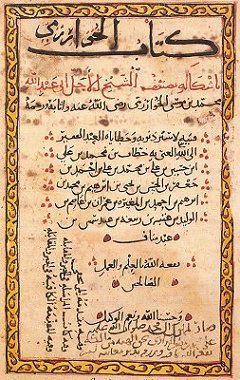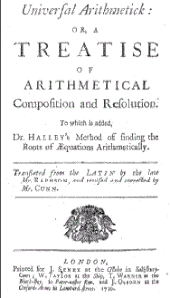Diophantus of Alexandria was a Greek mathematician, who was the author of two main works: On Polygonal Numbers, which survives incomplete, and the Arithmetica in thirteen books, most of it extant, made up of arithmetical problems that are solved through algebraic equations.
In numerical analysis, Newton's method, also known as the Newton–Raphson method, named after Isaac Newton and Joseph Raphson, is a root-finding algorithm which produces successively better approximations to the roots of a real-valued function. The most basic version starts with a real-valued function f, its derivative f′, and an initial guess x0 for a root of f. If f satisfies certain assumptions and the initial guess is close, then

Nicholas Saunderson was a blind English scientist and mathematician. According to one historian of statistics, he may have been the earliest discoverer of Bayes' theorem. He worked as Lucasian Professor of Mathematics at Cambridge University, a post also held by Isaac Newton, Charles Babbage and Stephen Hawking.

La Géométrie was published in 1637 as an appendix to Discours de la méthode, written by René Descartes. In the Discourse, Descartes presents his method for obtaining clarity on any subject. La Géométrie and two other appendices, also by Descartes, La Dioptrique (Optics) and Les Météores (Meteorology), were published with the Discourse to give examples of the kinds of successes he had achieved following his method.

Method of Fluxions is a mathematical treatise by Sir Isaac Newton which served as the earliest written formulation of modern calculus. The book was completed in 1671 and posthumously published in 1736.

Al-Jabr, also known as The Compendious Book on Calculation by Completion and Balancing, is an Arabic mathematical treatise on algebra written in Baghdad around 820 by the Persian polymath Al-Khwarizmi. It was a landmark work in the history of mathematics, with its title being the ultimate etymology of the word "algebra" itself, later borrowed into Medieval Latin as algebrāica.

Arithmetica is an Ancient Greek text on mathematics written by the mathematician Diophantus in the 3rd century AD. It is a collection of 130 algebraic problems giving numerical solutions of determinate equations and indeterminate equations.
John Collins FRS was an English mathematician. He is most known for his extensive correspondence with leading scientists and mathematicians such as Giovanni Alfonso Borelli, Gottfried Leibniz, Isaac Newton, and John Wallis. His correspondence provides details of many of the discoveries and developments made in his time, and shows his role in making some of these discoveries available to a wider audience. He was called "English Mersenne" for his extensive collecting and diffusing of scientific information.

Joseph Raphson was an English mathematician and intellectual known best for the Newton–Raphson method.
The history of mathematical notation includes the commencement, progress, and cultural diffusion of mathematical symbols and the conflict of the methods of notation confronted in a notation's move to popularity or inconspicuousness. Mathematical notation comprises the symbols used to write mathematical equations and formulas. Notation generally implies a set of well-defined representations of quantities and symbols operators. The history includes Hindu–Arabic numerals, letters from the Roman, Greek, Hebrew, and German alphabets, and a host of symbols invented by mathematicians over the past several centuries.
Algebra can essentially be considered as doing computations similar to those of arithmetic but with non-numerical mathematical objects. However, until the 19th century, algebra consisted essentially of the theory of equations. For example, the fundamental theorem of algebra belongs to the theory of equations and is not, nowadays, considered as belonging to algebra.
In mathematics, the Newton inequalities are named after Isaac Newton. Suppose a1, a2, ..., an are non-negative real numbers and let denote the kth elementary symmetric polynomial in a1, a2, ..., an. Then the elementary symmetric means, given by

A timeline of calculus and mathematical analysis.
This is a timeline of pure and applied mathematics history. It is divided here into three stages, corresponding to stages in the development of mathematical notation: a "rhetorical" stage in which calculations are described purely by words, a "syncopated" stage in which quantities and common algebraic operations are beginning to be represented by symbolic abbreviations, and finally a "symbolic" stage, in which comprehensive notational systems for formulas are the norm.
Richard Sault was an English mathematician, editor and translator, one of The Athenian Society. On the strength of his Second Spira he is also now credited as a Christian Cartesian philosopher.

Michael Stifel or Styfel was a German monk, Protestant reformer and mathematician. He was an Augustinian who became an early supporter of Martin Luther. He was later appointed professor of mathematics at Jena University.
John Radford Young was an English mathematician, professor and author, who was almost entirely self-educated. He was born of humble parents in London. At an early age he became acquainted with Olinthus Gilbert Gregory, who perceived his mathematical ability and assisted him in his studies. In 1823, while working in a private establishment for the deaf, he published An Elementary Treatise on Algebra with a dedication to Gregory. This treatise was followed by a series of elementary works, in which, following in the steps of Robert Woodhouse, Young familiarized English students with continental methods of mathematical analysis.

Summa de arithmetica, geometria, proportioni et proportionalita is a book on mathematics written by Luca Pacioli and first published in 1494. It contains a comprehensive summary of Renaissance mathematics, including practical arithmetic, basic algebra, basic geometry and accounting, written for use as a textbook and reference work.
Rao Saheb Dinanath Atmaram Dalvi was an Indian judge and amateur mathematician. His father, Atmaram Bapu Dalvi, was a social reformer and was Vice President of the Bombay Arya Samaj in 1880.










